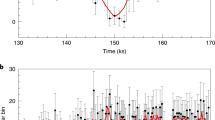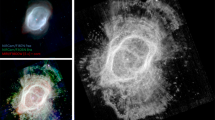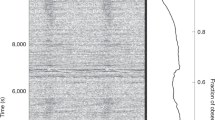Abstract
Cepheids are a class of variable (pulsating) stars whose absolute luminosities are related in a simple manner to their pulsational periods. By measuring the period and using the ‘period–luminosity’ relationship, astronomers can use the observed visual brightness to determine the distance to the star. Because these stars are very luminous, they can be observed in other galaxies, and therefore can be used to help determine the expansion rate of the Universe1 (the Hubble constant). Calibration of the period–luminosity relation is a necessary first step, but the small number of sufficiently nearby Cepheids has forced the use of a number of indirect means, with associated systematic uncertainties. Here we present a distance to the Cepheid ζ Geminorum, determined using a direct measurement (by an optical interferometer) of its changes in diameter as it pulsates. Within our uncertainty of 15 per cent, our distance is in agreement with previous indirect determinations. Planned improvements to the instrument will allow us to calibrate directly the period–luminosity relation to better than a few per cent.
This is a preview of subscription content, access via your institution
Access options
Subscribe to this journal
Receive 51 print issues and online access
$199.00 per year
only $3.90 per issue
Buy this article
- Purchase on Springer Link
- Instant access to full article PDF
Prices may be subject to local taxes which are calculated during checkout


Similar content being viewed by others
References
Mould, J. R. et al. The Hubble Space Telescope key project on the extragalactic distance scale. XXVIII. Combining the constraints on the Hubble constant. Astrophys. J. 529, 786– 794 (2000).
Wesselink, A. J. Surface brightnesses in the U, B, V system with applications of M V and dimensions of stars. Mon. Not. R. Astron. Soc. 144, 297–311 ( 1969).
Krockenberger, M., Sasselov, D. D. & Noyes, R. W. Radii and distances of Cepheids. I. Method and measurement errors. Astrophys. J. 479, 875– 885 (1997).
Tanvir, N. R. in Post-Hipparcos Cosmic Candles 17–35 (Kluwer, Dordrecht, 1999).
Mourard, D. et al. The mean angular diameter of δ Cephei measured by optical long-baseline interferometry. Astron. Astrophys. 317 , 789–792 (1997).
Kervella, P. et al. in Working on the Fringe: Optical and IR Interferometry from Ground and Space 22–27 (ASP Conf. Ser. 194, Astronomical Society of the Pacific, San Francisco, 1999).
Nordgren, T. et al. Astrophysical quantities of Cepheid variables measured with the NPOI. (in the press).
Szabados, L. Northern Cepheids: Period update and duplicity effects. Commun. Konkoly Observatory, Hungary 96, 123– 244 (1991).
Laney, C. D. & Stobie, R. S. The radii of galactic Cepheids. Mon. Not. R. Astron. Soc. 274, 337– 360 (1995).
Perryman, M. A. C. et al. The HIPPARCOS Catalogue. Astron. Astrophys. 323, L49–L52 (1997).
Colavita, M. M. et al. The Palomar Testbed Interferometer. Astrophys. J. 510, 505–521 ( 1999).
Colavita, M. M. Fringe visibility estimators for the Palomar Testbed Interferometer. Publ. Astron. Soc. Pacif. 111, 111– 117 (1999).
Boden, A. F. et al. An interferometric search for bright companions to 51 Pegasi. Astrophys. J. 504, L39– L42 (1998).
Bersier, D., Burki, G., Mayor, M. & Duquennoy, A. Fundamental parameters of Cepheids. II. Radial velocity data. Astron. Astrophys. 108, 25–39 ( 1994).
Hindsley, R. & Bell, R. A. An investigation of photoelectric radial-velocity spectrometers as used in the analysis of Cepheid variables. Publ. Astron. Soc. Pacif. 98, 881– 888 (1986).
Ridgway, S. T. et al. Angular diameters by the lunar occultation technique. IV—Alpha Leo and the Cepheid Zeta Gem. Astron. J. 87, 680–684 (1982).
Gieren, W. P., Barnes, T. G. & Moffett, T. J. The period-radius relation for classical Cepheids from the visual surface brightness technique. Astrophys. J. 342, 467–475 (1989).
Gieren, W. P., Barnes, T. G. & Moffett, T. J. The Cepheid period-luminosity relation from independent distances of 100 galactic variables. Astrophys. J. 418, 135–146 (1993).
McAlister, H. A. et al. Progress on the CHARA array. Proc. SPIE 3350, 947–950 (1998).
Cohen, M. et al. Spectral irradiance calibration in the infrared. X. A self-consistent radiometric all-sky network of absolutely calibrated stellar spectra. Astron. J. 117, 1864–1889 (1999).
Welch, D. L. Near-infrared variant of the Barnes-Evans method for finding Cepheid distances calibrated with high-precision angular diameters. Astron. J. 108, 1421–1426 (1999).
Claret, A., Diaz-Cordoves, J. & Gimenez, A. Linear and non-linear limb-darkening coefficients for the photometric bands R I J H K. Astron. Astrophys. 114, 247–252 (1995).
Acknowledgements
We thank R. Akeson, T. Armstrong, A. Bouchez, M. Colavita, T. Nordgren, M. Nunez and D. Sasselov for valuable comments. Part of the work described in this paper was performed at the Jet Propulsion Laboratory under contract with the National Aeronautics and Space Administration. This research has made use of the Simbad database, operated at Centre de Données astronomiques de Strasbourg, Strasbourg, France. B.F.L. gratefully acknowledges the support of NASA through the Michelson fellowship programme. B.F.L. acknowledges the support of NASA and the NSF.
Author information
Authors and Affiliations
Corresponding author
Rights and permissions
About this article
Cite this article
Lane, B., Kuchner, M., Boden, A. et al. Direct detection of pulsations of the Cepheid star ζ Gem and an independent calibration of the period–luminosity relation. Nature 407, 485–487 (2000). https://doi.org/10.1038/35035015
Received:
Accepted:
Issue Date:
DOI: https://doi.org/10.1038/35035015
This article is cited by
-
Asteroseismology and interferometry
The Astronomy and Astrophysics Review (2007)
-
The resolution revolution
Nature (2000)
Comments
By submitting a comment you agree to abide by our Terms and Community Guidelines. If you find something abusive or that does not comply with our terms or guidelines please flag it as inappropriate.



